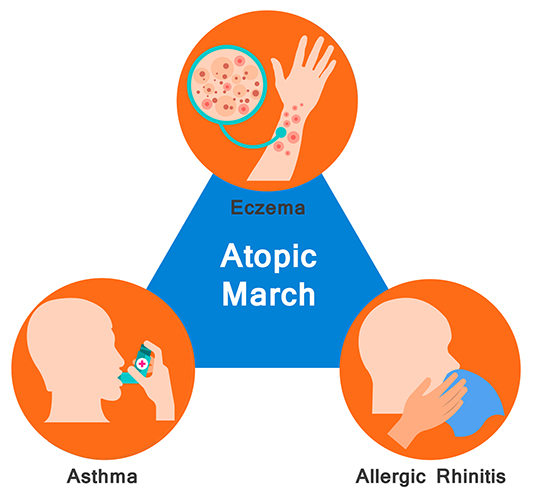When a person has an allergy, their immune system reacts to something they consume, touch, or inhale but not most other people, which is a condition that is frequently inherited. This substance causes the patient’s immune system to respond as though it were an “enemy invader” (like a virus). The tendency to develop allergy disorders is a genetically inherited feature, but a child’s environment or upbringing also influences how they develop. The Allergic (Atopic) March gets its name from the potential to have an allergic condition known as “atopy,” which makes one susceptible to developing additional allergic conditions.
Eczema (also known as atopic dermatitis), food allergies, allergic rhinitis or hay fever, and asthma are the four basic allergic disorders. Another explanation for the term “march” is that these illnesses and associated symptoms frequently manifest with aging in a particular order.
Even though the word “march” also suggests that each of these allergic illnesses progresses, a person may only experience certain of these allergic conditions in their lifetime. The allergy disorders that end up developing simply tend to manifest at specific ages in a particular order.
The Allergic March Triad
Asthma, eczema, and allergies frequently co-occur, and this is known as the atopic trio. Eczema is usually the first stage of the progression, followed by food allergies, asthma, and allergic rhinitis, which results in a runny nose and sneezing. This phenomenon is also called the “atopic march“.

The allergy march can happen at any moment, but it usually starts in early childhood because atopic dermatitis can be identified in infants as young as six months old. Although the allergy march’s order isn’t accurate, atopic dermatitis typically comes first, then food allergies, and eventually asthma and/or allergic rhinitis (hay fever). The general trend shows that there is a higher chance that someone with atopic dermatitis may later develop asthma and/or rhinitis the younger they are when they are first diagnosed with the condition or the more severe or persistent their atopic dermatitis is.
Atopic Dermatitis (Eczema) – First Condition
Atopic dermatitis, the first of the triad, is more frequently known as eczema. The most typical symptom of atopic dermatitis is dry, red, irritated, and itchy skin. Small, fluid-filled pimples appear on the skin and exude a clear or yellowish liquid. The fact that boys exhibit these reactions fairly early in life while girls exhibit them later in life suggests that gender differences may be at play in this situation. Additionally, consuming a specific food group may make the problem worse.
Allergic Rhinitis – Second Condition
Another illness known more commonly as hay fever is allergic rhinitis. Because of their numerous overlapping symptoms, such as watery, itchy eyes, a stuffy, runny nose, and sneezing, hay fever and the common cold are frequently mistaken for one another at first. Seasonal pollen is a major factor in the majority of allergic rhinitis causes.
Asthma – Last Condition
After the above two conditions asthma comes. It is the last stage in the allergic march. People with a past history of atopic dermatitis have a high risk of getting asthma.
Inflammation of the airways and repeated attacks of breathing difficulty are two features of the breathing condition asthma. The inflammation of the inflamed airways causes these episodes, often known as asthma attacks. Attacks of allergic asthma are brought on by the inhalation of allergens, which set off an allergic reaction. Allergens are non-harmful chemicals that cause an incorrect adverse immunological response in the body. Pollen, dust, and mold are examples of typical allergens. Asthma symptoms are a result of the immunological response.
Role of Food in Allergy March
Foods are generally the root cause of any allergy as the majority of certain foods, including tree nuts, fruits, peanuts, and vegetables, carry a risk of potentially fatal anaphylactic reactions and strong IgE responses. The only available treatment for food allergies in children is proper diet management, which must be followed for several years.
Ayurvedic Treatment of Allergic march
According to Ayurveda, allergies might result from an imbalance of the Doshas. When your Doshas are out of balance, allergic reactions worsen and your body becomes unable to rid itself of the poisons that have been collected because of a compromised immune system. The allergy develops into a chronic ailment when this problem lasts for a long time.
The unique method of Ayurveda is the secret to achieving lifelong advantages and holistic comfort from all ailments. Ayurvedic remedies specifically target the cause of the allergy rather than just treating the symptom. Ayurveda places a strong emphasis on increasing internal immunity through actions like eating a portion of good food, adopting a positive lifestyle, in addition to taking powerful herbs, and receiving rejuvenating Ayurvedic therapies.
The types of allergens that cause symptoms vary; some affect the skin and result in a combination of skin conditions, others may cause nasal congestion and other related respiratory problems, and some food allergies result in digestive problems that cause vomiting and bowel disorders, among other adverse health conditions. Depending on which Dosha is most aggravated, various people will experience distinct symptoms of particular diseases or conditions.
We at IAFA Ayurveda® provide safe and effective remedies prepared from natural herbs by following the principles of Ayurveda to treat Allergic March naturally. Contact us to get these remedies after consultation with our Health Experts.


